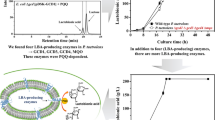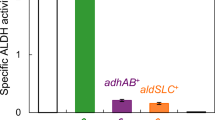Abstract
Shikimate and 3-dehydroshikimate are useful chemical intermediates for the synthesis of various compounds, including the antiviral drug oseltamivir. Here, we show an almost stoichiometric biotransformation of quinate to 3-dehydroshikimate by an engineered Gluconobacter oxydans strain. Even under pH control, 3-dehydroshikimate was barely detected during the growth of the wild-type G. oxydans strain NBRC3244 on the medium containing quinate, suggesting that the activity of 3-dehydroquinate dehydratase (DHQase) is the rate-limiting step. To identify the gene encoding G. oxydans DHQase, we overexpressed the gox0437 gene from the G. oxydans strain ATCC621H, which is homologous to the aroQ gene for type II DHQase, in Escherichia coli and detected high DHQase activity in cell-free extracts. We identified the aroQ gene in a draft genome sequence of G. oxydans NBRC3244 and constructed G. oxydans NBRC3244 strains harboring plasmids containing aroQ and different types of promoters. All recombinant G. oxydans strains produced a significant amount of 3-dehydroshikimate from quinate, and differences between promoters affected 3-dehydroshikimate production levels with little statistical significance. By using the recombinant NBRC3244 strain harboring aroQ driven by the lac promoter, a sequential pH adjustment for each step of the biotransformation was determined to be crucial because 3-dehydroshikimate production was enhanced. Under optimal conditions with a shift in pH, the strain could efficiently produce a nearly equimolar amount of 3-dehydroshikimate from quinate. In the present study, one of the important steps to convert quinate to shikimate by fermenting G. oxydans cells was investigated.




Similar content being viewed by others
References
Adachi O, Tanasupawat S, Yoshihara N, Toyama H, Matsushita K (2003a) 3-dehydroquinate production by oxidative fermentation and further conversion of 3-dehydroquinate to the intermediates in the shikimate pathway. Biosci Biotechnol Biochem 67:2124–2131
Adachi O, Yoshihara N, Tanasupawat S, Toyama H, Matsushita K (2003b) Purification and characterization of membrane-bound quinoprotein quinate dehydrogenase. Biosci Biotechnol Biochem 67:2115–2123
Adachi O, Ano Y, Toyama H, Matsushita K (2006a) Enzymatic preparation of metabolic intermediates, 3-dehydroquinate and 3-dehydroshikimate, in the shikimate pathway. Biosci Biotechnol Biochem 70:3081–3083
Adachi O, Ano Y, Toyama H, Matsushita K (2006b) High shikimate production from quinate with two enzymatic systems of acetic acid bacteria. Biosci Biotechnol Biochem 70:2579–2582
Adachi O, Ano Y, Toyama H, Matsushita K (2006c) Purification and properties of NADP-dependent shikimate dehydrogenase from Gluconobacter oxydans IFO 3244 and its application to enzymatic shikimate production. Biosci Biotechnol Biochem 70:2786–2789
Adachi O, Ano Y, Akakabe Y, Shinagawa E, Matsushita K (2008a) Coffee pulp koji of Aspergillus sojae as stable immobilized catalyst of chlorogenate hydrolase. Appl Microbiol Biotechnol 81:143–151
Adachi O, Ano Y, Toyama H, Matsushita K (2008b) A novel 3-dehydroquinate dehydratase catalyzing extracellular formation of 3-dehydroshikimate by oxidative fermentation of Gluconobacter oxydans IFO 3244. Biosci Biotechnol Biochem 72:1475–1482
Adachi O, Ano Y, Shinagawa E, Yakushi T, Matsushita K (2010) Conversion of quinate to 3-dehydroshikimate by Ca-alginate-immobilized membrane of Gluconobacter oxydans IFO 3244 and subsequent asymmetric reduction of 3-dehydroshikimate to shikimate by immobilized cytoplasmic NADP-shikimate dehydrogenase. Biosci Biotechnol Biochem 74:2438–2444
Bethesda Research Laboratories (1986) BRL pUC host: E. coli DH5a competent cells. Bethesda Res Lab Focus 8:9–12
Boyer HW, Roulland-Dussoix D (1969) A complementation analysis of the restriction and modification of DNA in Escherichia coli. J Mol Biol 41:459–472
Chandran SS, Yi J, Draths KM, von Daeniken R, Weber W, Frost JW (2003) Phosphoenolpyruvate availability and the biosynthesis of shikimic acid. Biotechnol Prog 19:808–814
Chaudhuri S, Lambert JM, McColl LA, Coggins JR (1986) Purification and characterization of 3-dehydroquinase from Escherichia coli. Biochem J 239:699–704
Dulley JR, Grieve PA (1975) A simple technique for eliminating interference by detergents in the Lowry method of protein determination. Anal Biochem 64:136–141
Figurski DH, Helinski DR (1979) Replication of an origin-containing derivative of plasmid RK2 dependent on a plasmid function provided in trans. Proc Natl Acad Sci U S A 76:1648–1652
Garbe T, Servos S, Hawkins A, Dimitriadis G, Young D, Dougan G, Charles I (1991) The Mycobacterium tuberculosis shikimate pathway genes: evolutionary relationship between biosynthetic and catabolic 3-dehydroquinases. Mol Gen Genet 228:385–392
Hanke T, Richhardt J, Polen T, Sahm H, Bringer S, Bott M (2012) Influence of oxygen limitation, absence of the cytochrome bc 1 complex and low pH on global gene expression in Gluconobacter oxydans 621H using DNA microarray technology. J Biotechnol 157:359–37
Kawai S, Goda-Tsutsumi M, Yakushi T, Kano K, Matsushita K (2013) Heterologous overexpression and characterization of a flavoprotein–cytochrome c complex fructose dehydrogenase of Gluconobacter japonicus NBRC3260. Appl Environ Microbiol 79:1654–1660
Kovach ME, Elzer PH, Hill DS, Robertson GT, Farris MA, Roop RM 2nd, Peterson KM (1995) Four new derivatives of the broad-host-range cloning vector pBBR1MCS, carrying different antibiotic-resistance cassettes. Gene 166:175–176
Larkin MA, Blackshields G, Brown NP, Chenna R, McGettigan PA, McWilliam H, Valentin F, Wallace IM, Wilm A, Lopez R, Thompson JD, Gibson TJ, Higgins DG (2007) Clustal W and Clustal X version 2.0. Bioinformatics 23:2947–2948
Prust C, Hoffmeister M, Liesegang H, Wiezer A, Fricke WF, Ehrenreich A, Gottschalk G, Deppenmeier U (2005) Complete genome sequence of the acetic acid bacterium Gluconobacter oxydans. Nat Biotechnol 23:195–200
Richman JE, Chang YC, Kambourakis S, Draths KM, Almy E, Snell KD, Strasburg GM, Frost JW (1996) Reaction of 3-dehydroshikimic acid with molecular oxygen and hydrogen peroxide: products, mechanism, and associated antioxidant activity. J Am Chem Soc 118:11587–11591
Roszak AW, Robinson DA, Krell T, Hunter IS, Fredrickson M, Abell C, Coggins JR, Lapthorn AJ (2002) The structure and mechanism of the type II dehydroquinase from Streptomyces coelicolor. Structure 10:493–503
Sambrook J, Russel DW (2001) Molecular cloning: a laboratory manual, 3rd edn. Cold Spring Harbor Laboratory Press, Cold Spring Harbor
Schein CH, Noteborn MHM (1988) Formation of soluble recombinant proteins in Escherichia coli is favored by lower growth temperature. Nat Biotechnol 6:291–294
Strandberg L, Enfors SO (1991) Factors influencing inclusion body formation in the production of a fused protein in Escherichia coli. Appl Environ Microbiol 57:1669–1674
Studier FW, Moffatt BA (1986) Use of bacteriophage T7 RNA polymerase to direct selective high-level expression of cloned genes. J Mol Biol 189:113–130
Suzuki S, Sugiyama M, Mihara Y, Hashiguchi K, Yokozeki K (2002) Novel enzymatic method for the production of xylitol from d-arabitol by Gluconobacter oxydans. Biosci Biotechnol Biochem 66:2614–2620
Tripathi P, Rawat G, Yadav S, Saxena RK (2013) Fermentative production of shikimic acid: a paradigm shift of production concept from plant route to microbial route. Bioprocess Biosyst Eng 36:1665–1673
van Kleef MA, Duine JA (1988) Bacterial NAD(P)-independent quinate dehydrogenase is a quinoprotein. Arch Microbiol 150:32–36
Vangnai AS, Toyama H, De-Eknamkul W, Yoshihara N, Adachi O, Matsushita K (2004) Quinate oxidation in Gluconobacter oxydans IFO3244: purification and characterization of quinoprotein quinate dehydrogenase. FEMS Microbiol Lett 241:157–162
Vangnai AS, Promden W, De-Eknamkul W, Matsushita K, Toyama H (2010) Molecular characterization and heterologous expression of quinate dehydrogenase gene from Gluconobacter oxydans IFO3244. Biochemistry (Mosc) 75:452–459
Whiting GC, Coggins RA (1967) The oxidation of d-quinate and related acids by Acetomonas oxydans. Biochem J 102:283–293
Acknowledgments
This work was supported in part by Grant-in-Aid from the Japan Society for the Promotion of Science.
Author information
Authors and Affiliations
Corresponding author
Electronic supplementary material
Below is the link to the electronic supplementary material.
ESM 1
(PDF 1180 kb)
Rights and permissions
About this article
Cite this article
Nishikura-Imamura, S., Matsutani, M., Insomphun, C. et al. Overexpression of a type II 3-dehydroquinate dehydratase enhances the biotransformation of quinate to 3-dehydroshikimate in Gluconobacter oxydans . Appl Microbiol Biotechnol 98, 2955–2963 (2014). https://doi.org/10.1007/s00253-013-5439-z
Received:
Revised:
Accepted:
Published:
Issue Date:
DOI: https://doi.org/10.1007/s00253-013-5439-z




